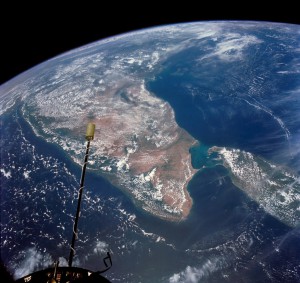The tag line for John Glenn’s piece in the 1967 World Book Year Book, entitled “Focus on Space,” read, “Despite the Gemini successes and the space probes to and around the moon, the year ended with a nagging problem unsolved.” Glenn in his piece provides a nice summary of the then-recently wrapped-up Gemini program, and acknowledges that during 1966, the United States seemed to pull ahead of the Soviets in the “Space Race,” accomplishing goals including useful EVAs, rendezvous, and docking, all aims that were critical during the more complex Apollo lunar missions. Indeed, 1966 was spaceflight’s grandest, most eventful year in its then short history.
However, Glenn (who by now had left NASA) adds a paragraph that in retrospect is greatly saddening. After giving a brief summary of the thus far successful Apollo test program, he added, “Project Apollo is expected to enter the manned flight stage early in 1967 when three astronauts are scheduled to fly an earth-orbital mission of up to 14 days [in] duration.” This first Apollo mission was to be flown by Glenn’s former Mercury 7 colleague Gus Grissom, who was 40, Gemini 4’s Ed White (36), and space rookie Roger Chaffee (who would’ve been the youngest American in space, having just turned 32).
As we know, this mission would never leave the planet, having been tragically thwarted on January 27, 1967, as the mission’s Apollo Block I capsule was felled by a fire that would kill all three men. Glenn optimistically continued, “Thus the objective of completing the first lunar exploration and return before the end of this decade still appears to be well within our reach. Manned spaceflight is now entering the third and final phase of this breathtaking adventure.” While Apollo did reach its goal before the decade’s end, it was not after an extensive redesign of Command Module, and the Block I design was never used for crewed missions.
An article by Andrew LePage describes what may have been if the Apollo 1 mission had launched as scheduled inFebruary 1967, and hewrote that the ambitious mission would’ve functioned not only as a test of the Command Module’s systems, but also “would set a new spaceflight endurance record beating that set by the crew of Gemini 7 by about quarter of an hour… With this successful flight, the way would be clear for the first Block II Apollo mission and manned LM test flight by McDivitt, Scott and Schweickart tentatively set for launch in August 1967.” Of course, the path to the moon was forever altered, but McDivitt’s crew would eventually fly their LM test flight in March 1969, about a year-and-a-half later than previously expected.
A Future of Uncertainty
Even as early as 1966, while he may have been overly sunny about Apollo’s direction, some of Glenn’s predictions about the future
of spaceflight were on point. He discusses Europe’s then-arduous journey to establishing their own space program: “The efforts of European nations to develop their own space organization ran into serious difficulties in 1966. Both ESRO and European Launch Development Organization (ELDO) have had funding problems from the start, and these came to a head with the withdrawal of considerable financial support by some member nations. It is probably still too early to make an accurate forecast, but such financial difficulties might well produce a still closer alignment of European interests in the U.S. program.”
While ESRO would enjoy success with its launch of ESRO 2B, an astronomy survey orbiter, in 1968, ELDO would continue to be plagued with growing pains that manifested in successive failures with its Europa launch vehicle. Two “package deals” would later lead to the creation of what is now known as the European Space Agency in 1975; this author wrote in an Ars Technica article, “As part of this package deal, ELDO would be shut down; France would bear the brunt of funding a new launch vehicle program, the LIIIS (Lanceur à Trois Etages de Substitution; this would later be called Ariane, the French name for the Greek goddess Ariadne). Germany would fund Spacelab, which rose from the ashes of a proposed ‘space tug’ collaboration between the United States and Europe. The modular lab, which would be installed in the US Space Shuttle’s cargo bay, was meant to be launched aboard the shuttle by 1980. According to ESA’s website, ‘Europe agreed to deliver free of charge the Engineering Model and the first Flight Unit, plus ground support equipment, in return for a shared first mission.’”
Glenn was not wrong in thinking the U.S and Europe would eventually collaborate, and by 1978 Europe boasted its first astronauts; in November 1983, Germany’s Ulf Merbold finally flew aboard Columbia/Spacelab 1. As of today, Europe has established a rich heritage in human and interplanetary spaceflight.
Most of interest is Glenn’s opinion about the future of U.S. spaceflight. He warned, “While Project Mercury determined that man could go safely into space, and Project Gemini built the know-how that enabled us to proceed to the lunar exploration of Project Apollo, there remained no clear-cut goal of what U.S. objectives should be beyond Apollo.” Glenn pointed out that “planning was underway in 1961 for Project Apollo equipment that will not be tested until 1967 and will not actually be put into use until lunar landing and return perhaps in 1969.” His portrayal of NASA is one that isn’t entirely positive – he added, “To get a mandate on the future direction of the space program is probably the single greatest problem facing NASA management.”
This last sentence could easily be written today. While NASA did eventually find a post-Apollo direction (encompassing Skylab, ASTP, and Shuttle/ISS), at present time the agency has turned its gaze from a “Journey to Mars” to (maybe?) revisiting the moon. But many critics of NASA characterize the post-Shuttle agency as having no “mandate on the future direction of the space program.” Of course, Glenn could have not foreseen commercial spaceflight endeavors at the time of writing his piece in the mid-1960s.
Later in the book, the “Space Exploration” section pops up, emblazoned with an exquisite (black and white) photo from the Gemini 11 mission, depicting India and Ceylon from 460 nautical miles up. But the section began with, “The nation’s exploits in 1966 were overshadowed early in 1967 by the tragic deaths of three U.S. astronauts in a routine test for what was to have been the first manned Apollo flight.” I couldn’t have summed up things better, as the piece added: “The tragedy seemed especially poignant because it came on the heels of a highly significant year in space.”
Conclusion
In the decades before the Internet made finding spaceflight information available at merely a mouse click, The World Book Encyclopedia sets captured the imaginations of many a space-obsessed kid, including this one. Their associated Year Books compiled events from the previous year, and these books – especially during the 1960s time frame – unveiled an increasingly sophisticated American space program. However, the words within the 1967 edition are prophetic, and sometimes downright chilling, predicting a future in space lacking concrete direction, while not predicting an unthinkable, yet preventable tragedy.
Carney, E. (2015, Dec. 31). “Space for Europe and for all mankind: A brief history of the ESA.” Ars Technica. Retrieved from http://arstechnica.com/science/2015/12/space-for-europe-and-for-all-humankind-a-brief-history-of-the-esa/
Glenn, J.H., Jr. (1967). “Focus on Space.” The World Book Year Book 1967. (pp. 44 – 49). Chicago, IL: Field Enterprises Educational Corporation.
Holmes, J. (1967). “Space Exploration.” The World Book Year Book 1967. (pp. 503 – 508). Chicago, IL: Field Enterprises Educational Corporation.
LePage, A. (2017, Jan. 27). “The Future That Never Came: The Unflown Mission of Apollo 1.” Drew Ex Machina. Retrieved from http://www.drewexmachina.com/2017/01/27/the-future-that-never-came-the-unflown-mission-of-apollo-1/
Emily Carney is a writer, space enthusiast, and creator of the This Space Available space blog, published since 2010. In January 2019, Emily’s This Space Available blog was incorporated into the National Space Society’s blog. The content of Emily’s blog can be accessed via the This Space Available blog category.
Note: The views expressed in This Space Available are those of the author and should not be considered as representing the positions or views of the National Space Society.





















